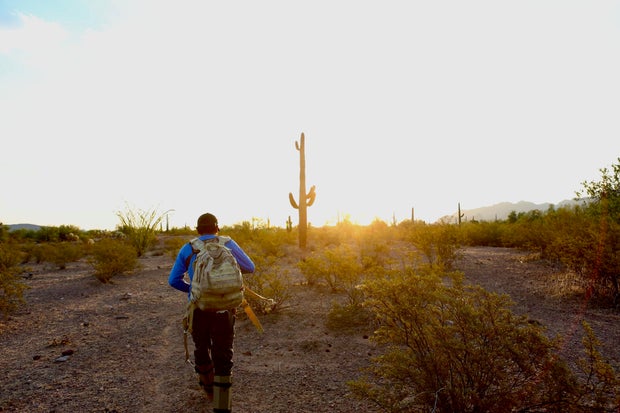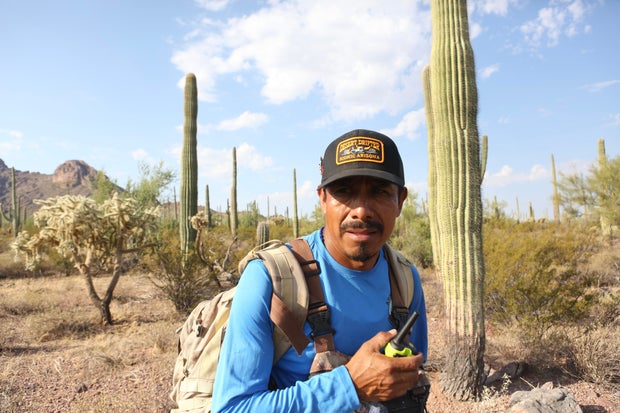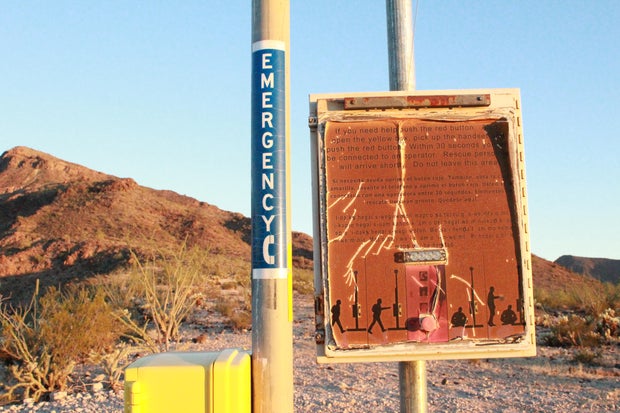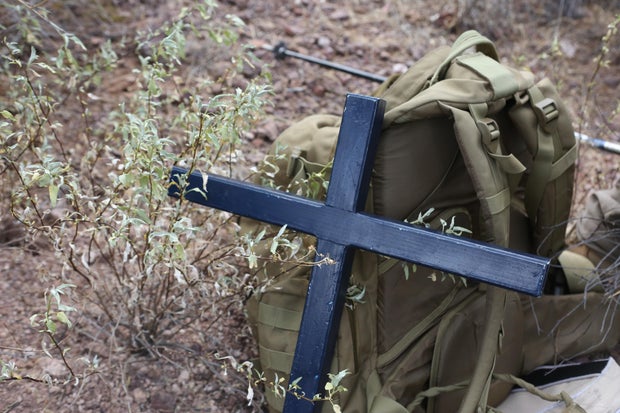Finding missing migrants along the U.S.-Mexico border, the world’s deadliest land migration route

Ajo, Arizona — The search began with a prayer in the early morning hours, as the sun emerged from the mountains that adorn this picturesque, yet often deadly, landscape near the U.S.-Mexico border.
It was the third search that a grassroots group of volunteers known as the Armadillos had embarked on this summer with the hopes of finding José Salinas Pineda, a 21-year-old Mexican migrant who had been missing since early June.
Back in their homes in southern California, the volunteers are construction workers, gardeners and cablemen. Like the people they look for, most are also immigrants. But in the desolate Arizona desert, the volunteers share a humanitarian mission: to offer some closure to distraught families by finding the remains of their loved ones.
“For me, it is not fair that this person stays here, in this place,” said Roberto Resendiz as the Armadillos huddled around him for a bilingual pep talk before the search. Resendiz, 48, is one of the leaders of the group.
Justo Robles / CBS News
By this place, Resendiz meant the barren Sonoran Desert. Migrants cross it every day to reach the U.S., despite the dangers of traversing an inhospitable terrain in temperatures that reach the triple digits during the summer.
Donning boots, shin guards, walking sticks and overstuffed backpacks, the volunteers carried ample amounts of water, electrolytes, cereal bars, medical kits and homemade wooden crosses to mark sightings of migrant remains.
As they began to scour a vast area inside the Organ Pipe Cactus National Monument, the volunteers only had three clues to find Salinas Pineda. They were told his traveling companions abandoned the young migrant when he became severely fatigued near a mountain known as “El Buda,” or the Buddha, a nod to its all-seeing, towering shape. He was wearing black shoes and camouflage gear.
A full-time construction worker, Resendiz said he has been searching for missing migrants at the U.S. southern border for about 18 years. He and other volunteers often fail to locate the people they’re looking for. Most of those they find are already dead. Those who are still alive are dehydrated and need medical attention.
Given the three months that had elapsed since Salinas Pineda went missing and their own experiences in the unforgiving desert, the Armadillos were well-aware that the chances of finding him alive were slim.
“It’s a long time,” Resendiz said. “But we can’t lose hope.”
Justo Robles / CBS News
“The deadliest land route for migrants”
Most of the migrants crossing into the U.S. as part of the record-spike in border crossings over the past several years have surrendered themselves to American immigration agents to begin an asylum process that typically takes years to complete.
But some migrants try to enter the country undetected, especially Mexican men, who are most at risk of being quickly deported if apprehended by U.S. agents. These migrants often travel through the most remote stretches of the border. The chances of slipping by without getting caught are higher, but so are the risks of perishing along the way.
The migration journey along the U.S.-Mexico border has long proved to be deadly for many. Between fiscal years 1998 and 2020, the U.S. Border Patrol recorded between 200 and 500 migrant deaths annually.
The death toll has become even more grim in recent years. The number of migrant deaths recorded by Border Patrol increased to 568 in fiscal year 2021 and then soared to nearly 900 in fiscal year 2022 — an all-time high. In fiscal years 2023 and 2024, Border Patrol recorded 704 and 560 migrant deaths respectively, according to unpublished agency data obtained by CBS News.
The deaths prompted the United Nations to call the U.S.-Mexico border “the deadliest land route for migrants worldwide.”
Customs and Border Protection officials told CBS News the sharp increase in recorded migrant deaths in recent years mainly reflects the overall record-setting increase in encounters of migrants over that period. But advocates say government policy also plays a role. They argue that harsher border rules, like the partial asylum ban enacted by President Biden in June, encourage migrants to try to enter the country in remote areas to avoid being detained and deported.
Justin De La Torre, the deputy chief Border Patrol agent in the Tucson sector, said the advocates’ assertions are “simply untrue.” He noted that the government has set up programs for migrants to enter the U.S. legally and safely, including through a system that allows 1,500 people to be processed at legal entry points each day. He said CBP also uses helicopters, rescue beacons and other resources to locate and assist migrants stranded in the desert.
“The decision to cross in the most remote locations along the southwest border is a decision that the criminal organizations make, and they alone make that decision,” De La Torre said, referring to smugglers who guide migrants across the border for a steep price.
Justo Robles / CBS News
In Texas, migrants sometimes drown in the Rio Grande. In other areas, migrants fall to their death after climbing the border wall. But the Arizona desert consistently sees the highest number of deaths across the border, federal and local statistics show.
In Pima County, which covers a large swath of the Arizona border, the medical examiner has discovered nearly 4,000 migrant remains since the turn of the century — or an average of 165 each year. The remains range from fully fleshed bodies and those decomposing after several days in the desert, to the skeletons of migrants who have been missing for months.
According to the Pima County Medical Examiner, the most common profile of someone whose corpse is found in the desert fits Salinas Pineda’ description: a Mexican male between the ages of 20 and 29.
“Paying” for the American Dream
Lucero Salinas Pineda, 29, said she was in disbelief when she heard her brother had gone missing. If anyone would survive the trek north, she thought, it would be her brother, a young and fit man who had received military training in Mexico.
Before migrating, Salinas Pineda was tasked by the Mexican military with busting illicit drug operations in the state of Sinaloa, known as one of the epicenters of a trafficking route by the country’s cartels, according to his sister. Because of the nature of his work, Salinas Pineda grew increasingly concerned about his family’s safety in Mexico, Lucero said.
Lucero Salinas Pineda
Those concerns prompted Salinas Pineda to leave Morelos, a state in central Mexico, where he lived with his sister and parents. In early June, he reached the Arizona-Mexico border, with plans to work in California for a few years and send money back home.
“My brother left on Saturday, June 1, when I received the last message from him, around 2:08 in the afternoon,” Lucero said in Spanish.
Lucero said she and her parents tried calling Salinas Pineda repeatedly, to no avail. Eventually, she said the family was told her brother had been left behind in the desert by the people who smuggled him into the U.S. for an $8,000 fee.
A lawyer by trade, Lucero began a frantic search for her brother, contacting anyone who might have information on his whereabouts. She said she managed to get ahold of Border Patrol officials, the Mexican consulate in Tucson and even the migrants traveling with her brother, who she said were arrested and deported to Mexico.
After hitting dead end after dead end, she researched other ways to find him, eventually locating volunteers who scour the border for missing migrants.
That’s when Resendiz and the Armadillos decided to help. The search by the Armadillos earlier this month in the Sonoran desert was the third and last search dedicated solely to finding Salinas Pineda.
Justo Robles / CBS News
After walking for nine hours through 12 miles of rugged terrain filled with cacti and monsoon creeks with a group of reporters, the Armadillos found an animal bone, water jugs and clothes that had been presumably abandoned by migrants who may have managed to get out of the desert. But there were no signs of Salinas Pineda.
Days after that unsuccessful search, Lucero said she has even thought about finding a way to get to the U.S. to walk across the Arizona desert herself in search of her brother.
Lucero had been concerned about her brother’s trip before he journeyed north.
“If something happens to you,” she remembers telling him, “guess who will be looking for you? I will be the only one who will look for you.”
“I told him, ‘Are you sure you want to go?'” Lucero recounted. “He had the example of my father, who had migrated to accomplish the American dream in the U.S., which we are now paying for.”
Still, Lucero says she’s hopeful her brother is somewhere out there, alive but unable to reach her and their family.
“I know that my brother, wherever he is, knows that I’m looking for him,” Lucero said.
Justo Robles / CBS News















